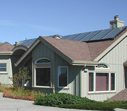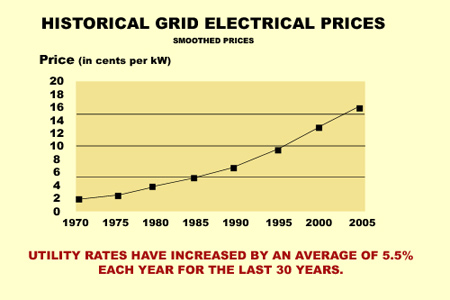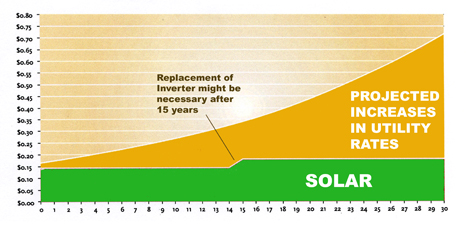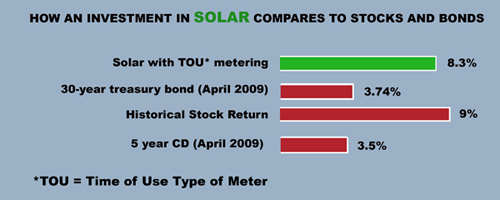
ON-THE-GRID SOLAR - FOR YOUR HOME & BUSINESS
What is On-The-Grid-Solar?
The new method of solar photovoltaic installation is to connect customer solar arrays to the utility grid. This eliminates the significant expense of battery storage. Electricity produced by the solar panels, over and above what is being used onsite, flows back into the electrical utility grid and your meter runs backward. 
The beauty of the system, dollar wise, is that the disadvantage of PG&E small baseline kWh allotments, coupled with the tier/peak rate penalty system that results in such high utility bills, becomes an advantage for the utility customer with a solar PV system because:
 PG&E must buy back power at the same rates that they charge for a given time frame and
PG&E must buy back power at the same rates that they charge for a given time frame and- Solar panels are producing the most electricity during the highest rate time frames (daytime summer high rates and peak usage).
The result is that, even though the solar panels don't produce as much electricity as a customer actually uses during a whole year, a properly sized PV array generating at premium rates can completely eliminate utility bills. With the new financing options available, one can even finance the system for the amount of the utility bill, so there is no increased out-of-pocket expense. After the loan is paid off, the system results in positive cash flow by way of little or no utility bills (see Net Metering Section below).
SOLAR SYSTEM SIZE - RESIDENTIAL & COMMERCIAL
Residential - What Size Solar System Do I Need?
 Thern Electric & Solar residential power systems require approximately 100 sq. ft. of panel area to generate 1 kilowatt of electricity. An average 2,500 sq. ft, single-family home uses about 5,000 kilowatt-hours of electricity per year. A 3 kW (AC) system, using a 300 sq. ft. area, will generate nearly all of the electricity required for such a home on an annual basis. Whether you are concerned about significantly reducing your CO2 emissions to help fight global warming, or concerned about the prospect of paying ever-increasing utility bills, solar PV offer real solutions.
Thern Electric & Solar residential power systems require approximately 100 sq. ft. of panel area to generate 1 kilowatt of electricity. An average 2,500 sq. ft, single-family home uses about 5,000 kilowatt-hours of electricity per year. A 3 kW (AC) system, using a 300 sq. ft. area, will generate nearly all of the electricity required for such a home on an annual basis. Whether you are concerned about significantly reducing your CO2 emissions to help fight global warming, or concerned about the prospect of paying ever-increasing utility bills, solar PV offer real solutions.
Residential System Cost On-the-grid solar systems (systems that do not require batteries) cost between $5-7 per watt installed. The exact system cost will depend upon the ease of the installation and access for roof mounted or ground mounted systems. A 3kW system that would power a typical California residence with good southern exposure will cost between $15,000 and $21,000 installed. After taking into account the California Cash Rebate and the Federal Solar Investment Tax Credit of 30%, the net cost of these systems ranges from approximately $13,545 to $15,645.
![]()
Commercial - What size solar system?
Solar Energy for Business is a smart solution: wineries, hotels, commercial buildings, retail stores and many others. Today, more and more business owners are making the decision to go solar. The benefits of solar for your busines are substantial:
- Reduce significantly your costs for electric and/or gas utility expenses
- Increase the value of your commercial property
- There are major tax benefits available only to businesses
- Gain the respect and loyalty of your customers and attract new customers by being Green
California Solar Initiative (CSI) Rebate
Financing an On-the-Grid Solar Power System
Pay no more each month for your solar system than you do now for your electrical bill. Here's a summary of how it works:
- Using your utility bill, Thern Electric & Solar will analyze your kilowatt usage and costs over a 12-month period.
- We size your system to generate the number of kilowatts needed to reduce your electrical bill to zero.
- You use the money that you would have paid to your electrical provider as a payment on your system.
Below is an example of how you could finance a 3kW system that would power an average-sized California home, taking into account the CSI rebate (see below) and the 30% Federal Investment Tax Credit.
| PV system size (kW-AC) | 3kW |
| Estimated Installed Cost (note 1 below) | $18,000 |
| CA Cash Rebate ($.25/kW) (see note 4 below) | $750 |
| Federal 30% Investment Tax Credit (taken at the end of 1st year -note 5 below) | $5,400 |
| Net Cost After Rebate and Tax Credit | $11,850 |
| Monthly Payment on a financed system - 15 year (note 2 below) | $93.71 |
| Monthly Payment after interest tax deduction - 15 year (see note 6 below) | $27.88 |
| Monthly Payment to PG&E for same number of kwh3 (note 3 below) | $208 |
| MONTHLY SAVINGS TO CUSTOMER for 15 year: | $86.41 |
| MONTHY SAVINGS YEAR 16 TO 30 (note 7 below) | $208 |
- Actual price will depend on cost of installation and type of panel mount.
- Average payment on $18,000 loan financed with 5% fixed rate mortgage with 15 year loan term (see amortization chart).
- Average over 30 years (the expected life of a PV panel solar array). Assumes homeowner is paying average rate of 16.5 cents per kwh today (some penalty zone usage), with 6% PG&E annual rate inflation.
- The PG&E incentive may be adjusted depending on orientation and shading of the installed system, as well as the incentive tier at the time of application.
- The 30% Federal Investment Tax Credit is calculated on: SYSTEM COST minus CA REBATE (see amortization chart).
- The interest on your solar loan is tax deductible. The interest deduction calculated is averaged over 360 months.
- This example is for a 15 year loan -beginning with year 16, the savings to the customer would be little or no electrical bill payments.
Electric Utility Rate Inflation in California: The Really Big Savings
The biggest savings from installing a solar electric system will be realized in future years. The historical electrical prices graph shown below is based upon rate data from the California Public Utility Commission. As you can see below, average electric rates have increased from approximately $0.02/kilowatt-hour in 1970 to $0.16/ kilowatt-hour in 2001. That is an average rate of increase of 5.5% per year. By investing in a solar system, you can stabilize your electricity costs and shield yourself from such utility rate hikes.

The Cost of Electricity in California - The Penalty Zones
The electric utility companies in California have adopted a complex tiered electric rate structure. This electric rate schedule establishes a 'baseline' rate for all electric usage each month. Usage up to the baseline amount is charged one rate, and usage above baseline is charged at a series of increasing tiered rates. Residential customers who exceed their baseline quantities face steep penalty rates The table below shows the rate structure for residential Pacific Gas & Electric customers.
Current Electric Rates & Penatlies
| Tier# | Percent of Baseline Consumption | Price per kWh |
|---|---|---|
| Tier 1 | Up to the baseline amount | 11.9¢ |
| Tier 2 | Electric Usage from 101% to 130% | 11.94¢ |
| Tier 3 | Electric Usage from 131% to 200% | 21.5¢ |
| Tier 4 | Electric Usage from 201% to 300% | 30.34¢ |
| Tier 5 | Electric Use exceeding 300% | 34.97¢ |
Comparison of Rates (price per kW) Over 30 Years

The Bottom Line
The graph below shows projected savings for a typical 3kW residential solar system. With financing, the homeowner would not need to spend any cash up front to pay for the system, and would get a tax benefit in the first year equal to 30% off the system cost. Over the life of the system, the homeowner would save nearly $38,000 in after-tax ~monthly payments. Solar is one of the best investments you will ever make.

Thern Electric & Solar Will Obtain the Best Pricing for Your System
Because Thern Electric & Solar is not affiliated with any manufacturer and thus required to quote that manufacturers products, and because the prices of the different manufactures continually varies, we design your system using the latest best materials prices, which we pass on to you our customer.
For homeowners who would like a quote on a system, please print out our form.
For business owners, please call us at 707-252-8572.
 |
 |
 |
~ back to top ~
